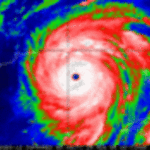After the September 11th terrorist attacks, there was a vigorous effort on the part of the US to increase emergency management effectiveness. Only a few years later, Hurricane Katrina further reinforced the need for comprehensive emergency management programs. A successful emergency management program is one that “…takes advantages of disparate elements to produce a synergistic reduction of risk and an increased capacity to respond (Canton, 2007).” Since risk reduction is a key indicator of a program’s effectiveness, it is essential that appropriate steps are taken in carrying out a risk assessment. Risk assessment should be the cornerstone of any emergency management program.
Although related, risk assessment is different from risk management. “Risk assessment performs risk identification, quantification, and measurement, while risk management involves the creative identification and meaningful evaluation of risk mitigation options (Leung, Lambert, & Mosenthal, 2004).” Risk assessment should answer three fundamental questions: 1) What can go wrong? 2) What is the likelihood that it would go wrong? and 3) What are the consequences? . By answering these questions, an emergency manager can decide the various risks that a community is likely to face and decide where to allocate precious program resources.
The first step of risk assessment is determining the various hazards that can affect the public. Then those hazards are ranked based on the likelihood of them occurring and the impact on the community when they do occur. Although a hazardous event or circumstance can potentially cause an emergency, the event itself does not necessarily offer a risk. Hazard events such as earthquakes, tornadoes, floods, terrorist attacks, etc. can result in disasters because of the behavior and actions taken at the governmental, community, and individual level (Rodriguez, Diaz, & Aguirre, 2004). Risk is created by the vulnerability of a community to the hazard’s impact and the likelihood of that hazard occurring. Risk assessment essentially analyzes these three key issues: impact, probability, and vulnerability (Canton, 2007).
Analyzing impact can be subjective because it is based on a community’s tolerance for risk. Levels of risk tolerance fluctuate from community to community. A hazardous event can have greater impact on a particular community whose effects are manipulated by cultural, social, economic, and political factors. Demographic and socioeconomic attributes can improve or worsen the impact of a hazard. Also, public policy decisions, such as enforcing or not enforcing land-use and building codes, will either alleviate or intensify the hazards’ effects (Rodriguez, Diaz, & Aguirre, 2004). When assessing risk, an emergency manager must decide on clear definitions of low risk, medium risk, etc. to accommodate risk tolerance because an inconvenience for one community may be a catastrophe for another.
Vulnerability stems from the susceptibility of a person, group, or community to incur damages from a disaster, and the difficulty experienced while recovering from these damages. Vulnerability is also defined as community characteristics that affect its capacity to foresee, deal with, resist, and recover from the impact of a hazard (Rodriguez, Diaz, & Aguirre, 2004). Generally speaking, community vulnerability to disasters has increased for several reasons. One reason is shifting demographic patterns, such as increased population density, and an increase in the elderly, physically disabled, and the poor. Furthermore, urbanization and urban sprawl, industrial development without adequate planning, and the development of communities in high risk areas such as flood plains, have also led to greater vulnerability.
Since the aim of risk assessment is to reduce the risk to communities in disaster situations, the information gained from any assessment must be used effectively. Emergency management practitioners and scholars have identified actions and technologies that reduce risk for particular disasters. The Federal Emergency Management Agency (FEMA) provides this information to state and local governments, individuals, and private industries, so that they can target their efforts at reducing the risk of the most destructive disasters (Roberts, 2007). Part of risk assessment involves ensuring that this information is reliable and accurate, and that it is communicated in a way that elicits an appropriate response from the public.
Research demonstrates that there a number of variables that determine whether or not a population will take risk seriously and take appropriate action. “The clarity of the message, its consistency and frequency, the presence and respectability of officials providing the warning, the accuracy of past warnings, and the frequency of the hazard will have a significant impact on the credibility of the message and on individual response to the same (Rodriguez, Diaz, & Aguirre, 2004).” Information must be communicated with the intent of influencing the population’s perception of risk. If a community perceives that they are at a high risk of being impacted by an event then it can be expected to take initiative to reduce the loss of life, injuries, and property damage. Therefore, it is important to maintain trust and public confidence in the sources that provide risk related information.
Effectively communicating the risks to the general population is only one of many challenges encountered during the risk assessment component of emergency management. Another challenge involves the balancing of the best and worst of worst-case planning. Public officials encounter an ostensibly endless variety of threats and are forced to place these threats in order of concern. The Department of Homeland Security (DHS) adopted a form of ranking threats based on a worst-case analysis to organize its disaster preparation efforts. A worst-case analysis poses the most devastating of disaster scenarios and seeks to reduce the likelihood of these scenarios and mitigate their impact. This analysis can enhance assessment of a previously neglected field, such as domestic terrorist attacks. However, planning for nightmare scenarios diverts attention and funds from more frequent scenarios that cause damage over time (Roberts, 2007).
The division of responsibility between federal, state, and local governments is also an issue with regards to risk assessment. Often times, the prospect of federal aid dissuades states and local governments from taking responsibilities in various phases of disaster risk management. The Disaster Mitigation Act of 2000 requires state and local governments to have approved hazard mitigation plans that include risk assessments, to be eligible for certain funds such as the Hazard Mitigation Grant Program. Hurricane Katrina has fueled the debate on whether mitigation should stem from grants funded by the federal government, or if it is the primary responsibility of local communities and private owners to defend themselves (Gopalakrishnan, & Okada, 2007).
Since a single risk assessment accrediting body does not exist, states and localities conduct risk assessments only haphazardly. The more resources an area has, the more effective of a risk assessment will be carried out. Comprehensive risk assessments require the time and skills of a large staff, but rural counties may have only a single emergency management coordinator, and sometimes it is the police or fire chief (Roberts, 2007). Preliminary evidence indicates that most state and local agencies do not possess the resources to develop formal risk assessments.
There are also obstacles to risk-based assessment in the public policy process itself. For example, in early 2007, the White House Office of Management and Budget withdrew DHS plans to standardize risk assessment procedures due to criticism that the plan would change standard procedures (Roberts, 2007). Michael Chertoff’s rhetoric defined risk as a priority, but even still, DHS is unable to proceed with risk-based resource allocation as quickly as it would like because of the intrinsic problems associated with risk assessment. Also, different political actors control various stages of the reform process, making it more difficult to change policy.
Risk assessment must be a requirement for any comprehensive emergency management program. Risk assessment ultimately drives the advancement of emergency management strategy and the development of crisis-related planning. However, it is also apparent that inherent problems associated with risk assessment pose serious challenges to the emergency manager. If a national risk assessment plan is to develop in the US, those many challenges will have to be overcome in order to reduce disaster losses over time. Since the Department of Homeland Security has become the governing body for emergency mitigation and response, any effort towards national risk assessment will likely start and end there.
References
Canton, L.G. (2007). Emergency Management: Concepts and Strategies for Effective
Programs. Hoboken, New Jersey: John Wiley & Sons.
Gopalakrishnan, C., & Okada, N. (2007). Designing new institutions for implementing
integrated disaster risk management: key elements and future directions. Disasters, 31(4), 353-372.
Leung, M., Lambert, J.H., & Mosenthal, A. (2004). A Risk-based approach to setting
priorities in protecting bridges against terrorist attacks. Risk Analysis, 24(4), 963-984.
Roberts, P. (2007). Toward a national hazards risk assessment. Journal of Homeland
Security and Emergency Management, 4(3), 1-15.
Rodriguez, H., Diaz, W., & Aguirre, B. (2004). Communicating risk and warnings: an
integrated and interdisciplinary research approach, Preliminary Paper # 337, Disaster Research Center, University of Delaware.






